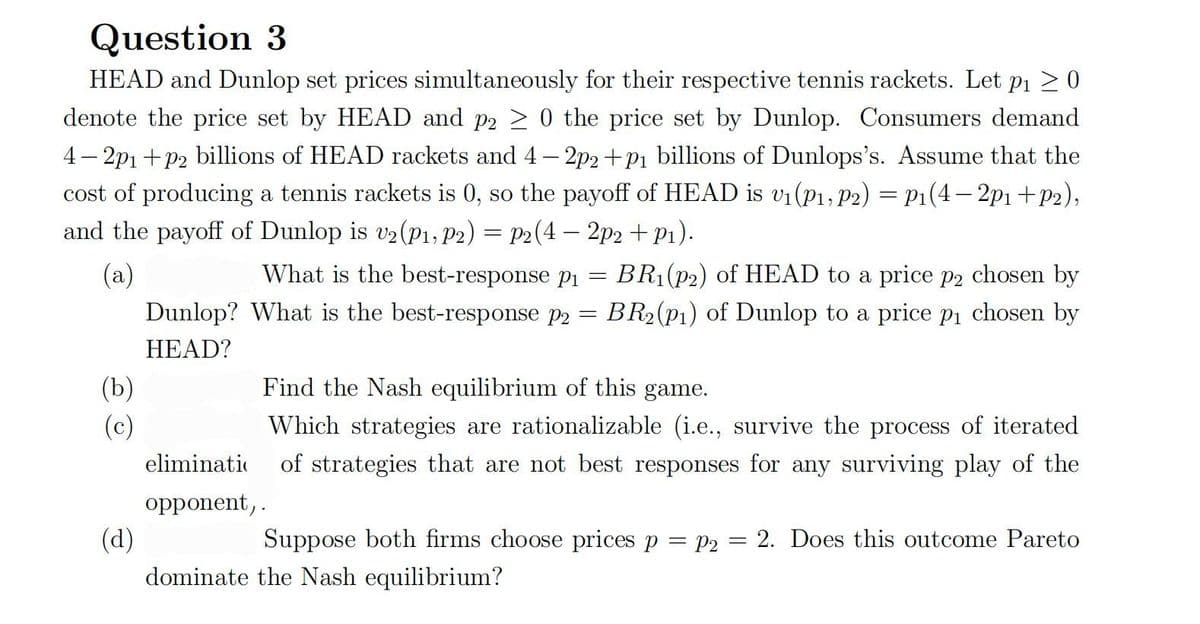Question 3 HEAD and Dunlop set prices simultaneously for their respective tennis rackets. Let p₁ ≥ 0 denote the price set by HEAD and p2 ≥ 0 the price set by Dunlop. Consumers demand 4-2p1+p2 billions of HEAD rackets and 4-2p2+P₁ billions of Dunlops's. Assume that the cost of producing a tennis rackets is 0, so the payoff of HEAD is v₁ (P₁, P2) = P₁(4-2p₁+P2), and the payoff of Dunlop is v₂ (P1, P2) = P2(4 — 2p2 +P₁). - (a) What is the best-response p₁ = BR₁(p2) of HEAD to a price p2 chosen by What is the best-response p2 = BR₂(p₁) of Dunlop to a price p₁ chosen by Dunlop? HEAD? (b) Find the Nash equilibrium of this game. (c) Which strategies are rationalizable (i.e., survive the process of iterated of strategies that are not best responses for any surviving play of the eliminatio opponent,. (d) Suppose both firms choose prices p = P2 = 2. Does this outcome Pareto dominate the Nash equilibrium?
Question 3 HEAD and Dunlop set prices simultaneously for their respective tennis rackets. Let p₁ ≥ 0 denote the price set by HEAD and p2 ≥ 0 the price set by Dunlop. Consumers demand 4-2p1+p2 billions of HEAD rackets and 4-2p2+P₁ billions of Dunlops's. Assume that the cost of producing a tennis rackets is 0, so the payoff of HEAD is v₁ (P₁, P2) = P₁(4-2p₁+P2), and the payoff of Dunlop is v₂ (P1, P2) = P2(4 — 2p2 +P₁). - (a) What is the best-response p₁ = BR₁(p2) of HEAD to a price p2 chosen by What is the best-response p2 = BR₂(p₁) of Dunlop to a price p₁ chosen by Dunlop? HEAD? (b) Find the Nash equilibrium of this game. (c) Which strategies are rationalizable (i.e., survive the process of iterated of strategies that are not best responses for any surviving play of the eliminatio opponent,. (d) Suppose both firms choose prices p = P2 = 2. Does this outcome Pareto dominate the Nash equilibrium?
Algebra & Trigonometry with Analytic Geometry
13th Edition
ISBN:9781133382119
Author:Swokowski
Publisher:Swokowski
Chapter9: Systems Of Equations And Inequalities
Section9.4: Linear Programming
Problem 13E
Related questions
Question

Transcribed Image Text:Question 3
HEAD and Dunlop set prices simultaneously for their respective tennis rackets. Let p₁ ≥ 0
denote the price set by HEAD and p2 ≥ 0 the price set by Dunlop. Consumers demand
4-2p₁+p2 billions of HEAD rackets and 4-2p2+p₁ billions of Dunlops's. Assume that the
cost of producing a tennis rackets is 0, so the payoff of HEAD is v₁ (P1, P2) = P₁(4-2p1+P2),
and the payoff of Dunlop is v2 (P1, P2) = P2(4- 2p2 + P₁).
(a)
=
What is the best-response p₁
What is the best-response p2
BR₁(p2) of HEAD to a price p2 chosen by
BR₂(p1) of Dunlop to a price p₁ chosen by
Dunlop?
=
HEAD?
(b)
Find the Nash equilibrium of this game.
(c)
Which strategies are rationalizable (i.e., survive the process of iterated
eliminati of strategies that are not best responses for any surviving play of the
opponent,.
(d)
Suppose both firms choose prices p = p₂ = 2. Does this outcome Pareto
dominate the Nash equilibrium?
Expert Solution
This question has been solved!
Explore an expertly crafted, step-by-step solution for a thorough understanding of key concepts.
Step by step
Solved in 3 steps with 3 images

Recommended textbooks for you

Algebra & Trigonometry with Analytic Geometry
Algebra
ISBN:
9781133382119
Author:
Swokowski
Publisher:
Cengage

Algebra & Trigonometry with Analytic Geometry
Algebra
ISBN:
9781133382119
Author:
Swokowski
Publisher:
Cengage